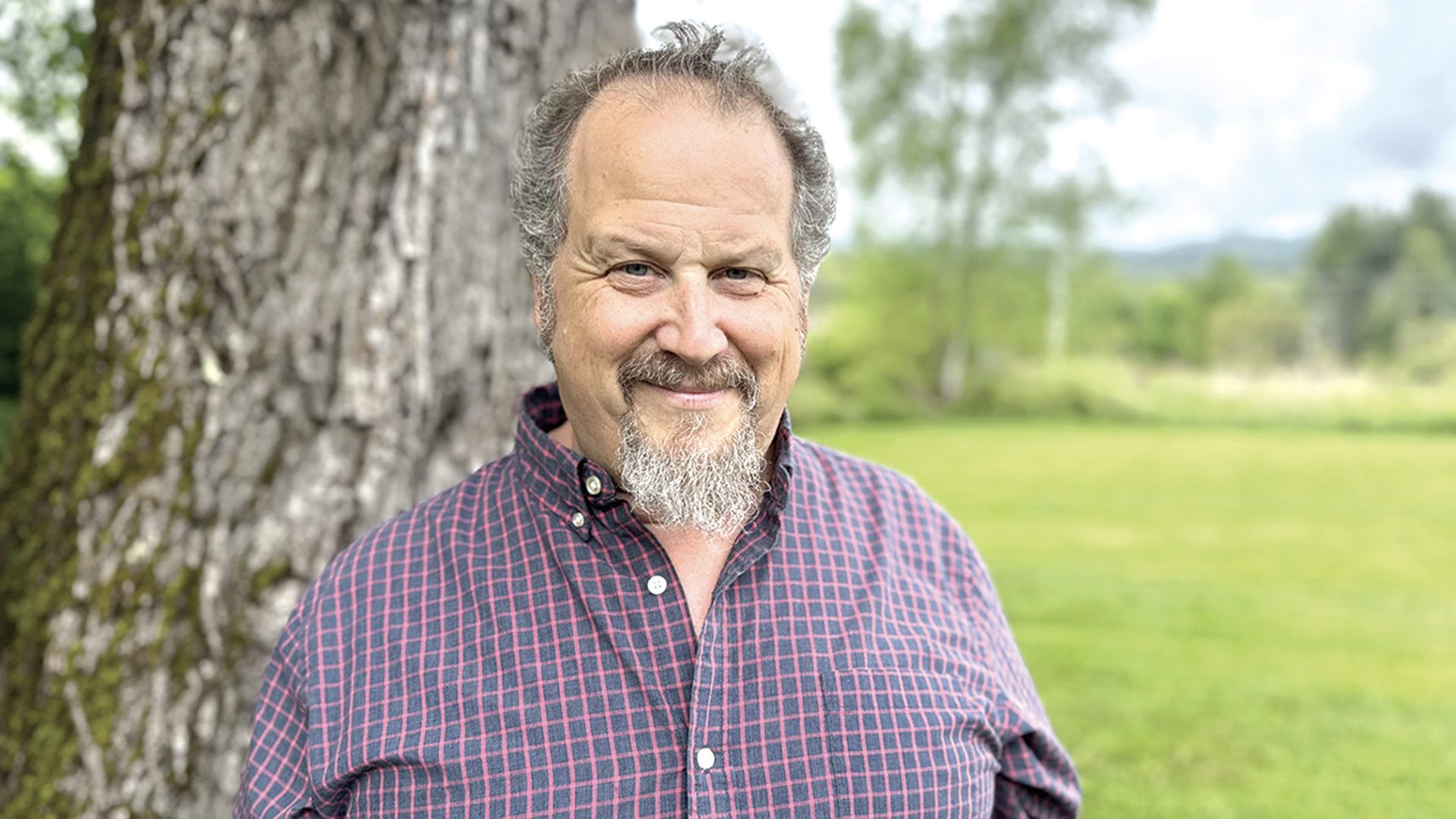
Dave Hayes Cultivates Community Around Weather
Beyond the Forecast

Dave Hayes
Like many New Englanders, Dave Hayes remembers the significant weather events of his childhood, like the Mother’s Day snowstorm that struck the region in 1977, dropping more than a foot of snow on parts of Massachusetts, and the Blizzard of 1978 that crippled much of Southern New England the following February.
But he also remembers something else weather-related from his youth: watching a Boston-area forecast, intrigued by the bright colors of the radar display, and then almost immediately watching the skies outside his living room grow dark, and a storm suddenly arise.
“Five minutes later, what was on the radar was overhead, and something lit up inside of me. I became obsessed with the weather,” he said — to the point where he’d flip between local TV forecasts to compare them. “I found I gravitated toward the meteorologist who explained why the weather is doing what it’s doing, rather than just what it’s doing.”
Hayes never lost that obsession with the weather, and it led to an unlikely, donation-funded career as Dave Hayes the Weather Nut, through which he posts and discusses the day’s current weather and upcoming forecast on social media, as his myriad followers converse about it all in the comments.
And there are a lot of followers — more than 57,000 on Facebook, in fact, and 6,600 on Twitter.
But while Hayes is widely known on Facebook today, early in 2011, he had become disenchanted with the site and deactivated his account.
“I didn’t get it yet. I didn’t understand virality and sharing with people and the idea that this might possibly be useful in some way.”
However, when a tornado struck Springfield and a host of other communities on June 1 of that year, he heard talk of his friends chattering online about what he thought about the destructive event. So he eventually logged back on and started talking more often about weather events. When an acquaintance complained that he was doing too much of that, Hayes decided to create a page separate from his personal account, called Dave Hayes the Weather Nut, where friends — or anyone else — could follow him if they wanted to.
And what a year that was for weather in Western Mass. — 2011 featured not only the tornado, but Tropical Storm Irene in August, the freak pre-Halloween snowstorm that felled countless trees, and a few other events. His reporting between 2011 and the summer of 2012 had about 200 people taking part in the local weather conversation, and his reports in the fall of 2012 on Hurricane Sandy — which seemed to be threatening New England before turning toward New Jersey — tripled that, to more than 600.
“People wanted to know what was going on,” he said. “I didn’t get it yet. I didn’t understand virality and sharing with people and the idea that this might possibly be useful in some way — a hub for weather that’s interesting. But I kept doing it.”

Dave Hayes collects raw data from numerous sources and uses it to craft his daily reports.
A blizzard in February 2013 saw Hayes’s audience crest to more than 1,000 people. “People said how helpful my work was to them. And as someone who hadn’t really launched in life yet, I wanted to be helpful to people. So that lit a fire inside of me, and I said, ‘I’m going to do this daily. This is something that people find useful.’”
When he began daily reports, which continue today, the audience doubled to 2,000, then swelled above 10,000 early in 2014, during a colder and snowier winter than any Western Mass. has seen since. Around the same time, he was laid off from a sales job when his company downsized due to the lingering effects of the Great Recession.
“Without a job, looking for work, not finding anything, I went deeper into weather reporting,” he said, and began attracting the attention of public radio, the Daily Hampshire Gazette, and other media — and wondering if this could actually become a career.
Weather or Not
Indeed, when the page was taking off in 2014, Hayes’s father and others in his life started asking him seriously if he could make a living at this, he recalled. “I said I didn’t know. I hadn’t even thought of it. I was just doing something I love.”
But around that time, crowdfunding was becoming more popular, so he threw up a GoFundMe link.
“Without a job, looking for work, not finding anything, I went deeper into weather reporting.”
“I figured, if people want to support my work financially, they’ll do it. If they think it has value, they’ll kick me a few bucks. I linked to it during big storms, and during 2015, I produced a crowdfunded support drive, about four or five weeks, talking about different aspects of what I was doing. I was teaching myself as I went along. It was a very unorthodox way of making a living.”
But Hayes did, in fact, begin to slowly generate a steady income through voluntary donations, and while he still does some paralegal work on the side, Dave Hayes the Weather Nut is, in fact, his living now. He compares the model to Patreon, a popular site through which people can directly support artists and writers producing content.
“It’s very unorthodox, how my life has played out,” he added. “You never know what’s going to happen until you work on something and share it with others.”
In creating daily content, Hayes curates his reports by gathering information from multiple sources, gathering data and modeling from the National Weather Service, private meteorological subscriptions, and personal weather stations, then creates his own forecasts and analysis that people from across Massachusetts and parts of Vermont, New Hampshire, and Connecticut have come to rely on.
“I’m not a meteorologist,” he said. “I pay for data subscriptions, read multiple forecast discussions from regional National Weather Service meteorologists, and obtain other trusted weather data in the Northeast region. I take all that information, along with my 35-plus years living in the Western Mass. region, and use my own process to produce my reports.”

Dave Hayes says winter storm trends can be slow-moving, while severe summer weather can emerge with little warning.
The next phase for Hayes will be a mobile app, which he plans to introduce in 2025, and which he hopes will replace his social-media presence, given a widespread problem of algorithms restricting the reach of social-media content creators — a real problem during fast-developing storms.
“Three out of four people look at my info from their smartphone, so I figured I need to have a way to reach people more directly, especially during the summer severe events,” he explained. “Winter storms develop more slowly. You see them building across the country over three or four days. But thunderstorms, microbursts, and tornadoes can form within five, 10, or 15 minutes.”
He plans to offer both free and paid versions of the app with different features, and will definitely retain the all-important interactive aspect, with users able to comment. After all, that may be the most compelling and popular aspect of his passion turned unlikely career.
“The way we watch the forecast has traditionally been on TV; you consume the forecast, and that’s it. There’s no conversation about it,” Hayes explained. “What I’ve tried to create with social media is a two-way street where we can go back and forth and answer as many questions as we can.”
It essentially adds another dimension to weather reports, one he’s been delighted to find so many people are passionate about.
“The way we watch the forecast has traditionally been on TV; you consume the forecast, and that’s it. There’s no conversation about it. What I’ve tried to create with social media is a two-way street where we can go back and forth and answer as many questions as we can.”
“People are talking to each other — ‘I got this much snow in Belchertown.’ ‘Oh, I got this much down in Palmer.’ It’s a whole community vibe around something that we all have to deal with. Everyone has unique lives, but we all have to deal with the weather. So by fostering this community, we can all talk about what’s impacting all of us.”
It also lends an element of “ground truth” in real time, he added. Because a temperature difference of a degree or two can turn rain into snow quickly, not only can he quickly adjust a report based on comments, but a weather forecast becomes not a static report, frozen in time, but a living, evolving thing.
Seeing the Light
Speaking of evolving, Hayes has taken note of the trend toward warmer, wetter winters over the past decade, as well as more flooding events. But he says he’s not a climatologist and continues to focus on his bread and butter — forecasting, reporting, and talking about each day’s weather with a growing fanbase in the tens of thousands.
Even “space weather,” as he put it, got plenty of attention recently, as followers snapped, shared, and commented on photos of the aurora borealis making a rare appearance across the U.S. on May 10. With the solar maximum not having hit its peak yet, such a shared experience might happen again within the next year or so.
“It was beautiful and otherworldly; humans think they’re amazing, and it really puts things into perspective, shows how small we are,” Hayes told BusinessWest. “But you don’t want too many solar storms. The Carrington Event in 1859 fried the entire telegraph system. One hundred and sixty-five years later, we’re a lot more reliant on the power grid for a lot of things. So while the aurora is fun to see, I don’t want to see it too often.”





